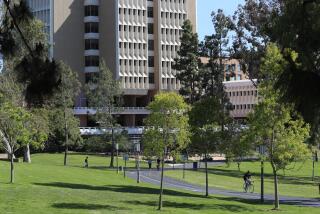Job program for foreign graduates of U.S. colleges has quadrupled in size

- Share via
Almost 1.5 million foreign students have been allowed to stay and work in the United States after graduation as part of a work permit program that now is larger than the controversial H-1B program for highly skilled foreign workers, according to a new report.
The number of students in the science, technology, engineering and math fields who are authorized to work under the Optional Practical Training program has soared 400% since 2008, when the federal government increased the amount of time graduates in those fields could stay in the U.S. and work, according to the Pew Research Center analysis of U.S. Immigration and Customs Enforcement data obtained through a Freedom of Information Act request.
The Los Angeles-Long Beach-Anaheim area is among the nation’s top destinations for graduates in the OPT program, Pew found. The report highlighted USC, which ranked first among private, not-for-profit schools for the number of program participants: 27,100 students during the 12-year period that ended in 2016. UCLA ranked third among public colleges, with 13,600 such students in that period.
The OPT program, which grew out of the Immigration and Nationality Act of 1952, essentially extends F-1 education visas for foreign college and university students so they can work during or after school. The program’s base-level permit lasts 12 months, but a STEM extension for those in the science, technology, engineering and math fields lets those participants spend an additional two years working in the U.S.
“We’ve seen this huge growth in foreign graduates staying under OPT, and most recently, it has surpassed the largest temporary-employment visa program, which is the H-1B,” said Pew researcher Neil Ruiz, author of the report issued Thursday, which covers the period from 2004 to 2016.
Although the H-1B program is heavily relied upon by Silicon Valley tech companies to employ highly skilled tech talent, it imposes restrictions, including an annual cap of 85,000, and requires workers to be sponsored by employers. There is no cap on the number of OPT recipients and no sponsorship requirement.
“The H-1B is harder to get,” Ruiz said, adding that OPT is often a pathway to an H-1B visa, but data is not available to show how many OPT participants receive H-1Bs.
More than half of those working under OPT from 2004 to 2016 were in science, technology, engineering and math fields and thus were eligible for the extension, Pew found. The program added a 17-month STEM extension in 2008, shortly after Microsoft co-founder Bill Gates suggested it in testimony to Congress after complaining that the cap for the H-1B program had “caused a serious disruption in the flow of talented STEM graduates to U.S. companies. In 2016, an additional 12-month extension was added.
OPT has caught the attention of critics pushing for reduced immigration. John Miano, a fellow at the Center for Immigration Studies, called the 2008 STEM extension a “scheme” by Microsoft to “circumvent the H-1B quotas.” The program started out giving work-experience opportunities to foreign students but since has been “transformed into a full-blown guestworker program whose stated purpose is to provide labor to American business,” Miano wrote in a September blog post for the center.
Baron writes for the San Jose Mercury News/McClatchy.
More to Read
Inside the business of entertainment
The Wide Shot brings you news, analysis and insights on everything from streaming wars to production — and what it all means for the future.
You may occasionally receive promotional content from the Los Angeles Times.









